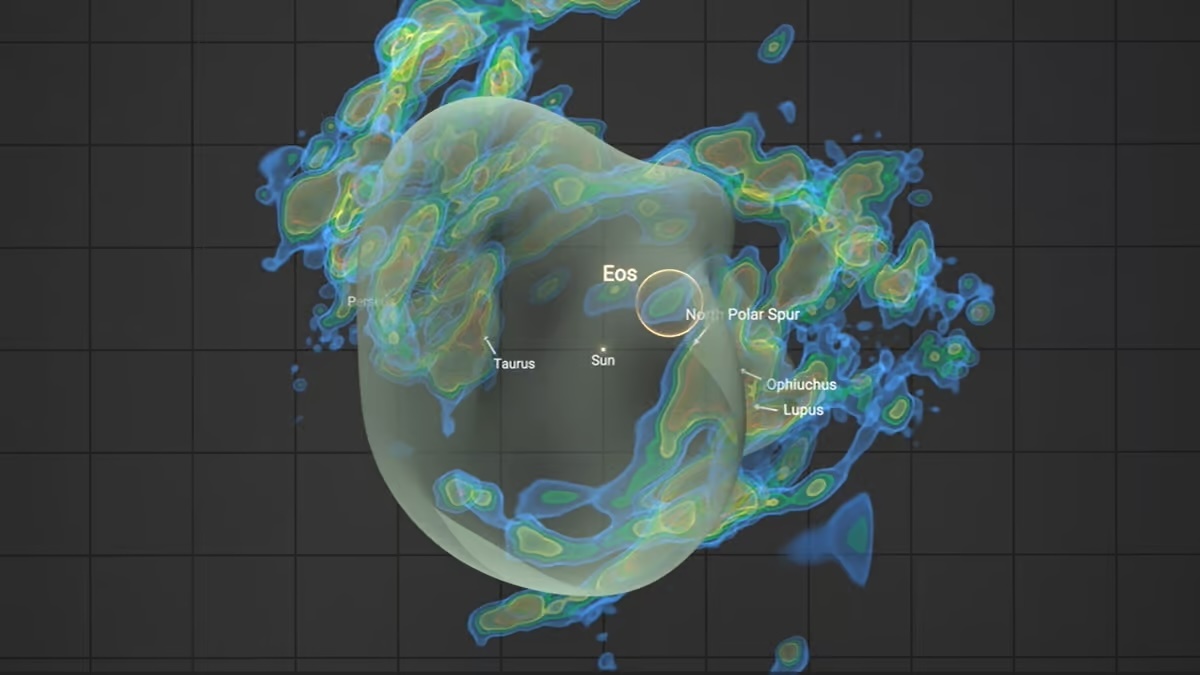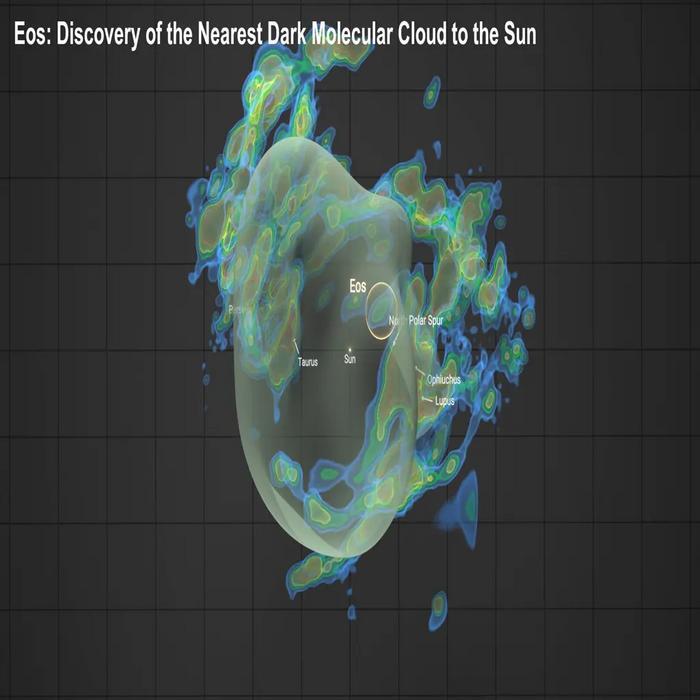29.04.2025

Credit: Thomas Müller (HdA/MPIA) and Thavisha Dharmawardena (NYU)
Astrophysicists have just discovered a vast molecular cloud right under our noses. Only 300 light-years away, this crescent-shaped cloud of gas and dust is invisible to the naked eye but is enormous – if we could see it in the night sky, it would take up the space of 40 Moons. It’s one of the largest single structures in the sky.
Molecular clouds like these are composed of molecules such as hydrogen and carbon monoxide. They are typically detected using radio or infrared observations, which can pick up the chemical signature for carbon monoxide (CO). But this cloud is “CO-dark”. It doesn’t emit the characteristic signature that conventional detection techniques see, and it has long eluded scientists, despite being in our galactic neighbourhood.
Instead, the cloud is primarily composed of molecular hydrogen. This isn’t easy to directly observe – but in this case, that’s exactly what astrophysicists achieved, by detecting the light emitted by the hydrogen itself.
The discovery is reported in Nature Astronomy.
“This is the first-ever molecular cloud discovered by looking for far ultraviolet emission of molecular hydrogen directly,” says Blakesley Burkhart, astrophysicist at Rutgers University-New Brunswick and leader of the team. “The data showed glowing hydrogen molecules detected via fluorescence in the far ultraviolet. This cloud is literally glowing in the dark.”
Burkhart and team discovered the cloud in a dataset taken by a far-ultraviolet spectrograph on the Korean satellite STSAT-1. The data was released publicly in 2023, when the team searched it using this innovative technique.
“It’s kind of wild that we can see this cloud in data that we didn’t think we would see,” Burkhart says. “This opens up new possibilities for studying the molecular universe.”
Co-author Thavisha Dharmawardena, a NASA Hubble Fellow at New York University, agrees: “The use of the far ultraviolet fluorescence emission technique could rewrite our understanding of the interstellar medium, uncovering hidden clouds across the galaxy and even out to the furthest detectable limits of cosmic dawn.”
Fittingly, the team dubbed the cloud “Eos”, after the Greek goddess of dawn.
Because of its relative proximity to Earth, Eos could help us better understand the interstellar medium – the gas and dust in the space between stars that serves as the raw material for stars and planets to form.
“When we look through our telescopes, we catch whole solar systems in the act of forming, but we don’t know in detail how that happens,” Burkhart says. “Our discovery of Eos is exciting because we can now directly measure how molecular clouds are forming and dissociating, and how a galaxy begins to transform interstellar gas and dust into stars and planets.”
The team is now scouring existing data for other molecular hydrogen clouds that have eluded us until now. They recently posted another pre-print study to arXiv, tentatively reporting finding the most distant molecular gas yet in data from the James Webb Space Telescope (JWST).
“Using JWST, we may have found the very furthest hydrogen molecules from the sun,” Burkhart says. “So, we have found both some of the closest and farthest using far-ultraviolet emission.”
Quelle: COSMOS
+++
A vast molecular cloud, long invisible, is discovered near solar system
The detection of the celestial body by a Rutgers-led team could redefine understanding of interstellar medium

SCIENTISTS HAVE DISCOVERED A POTENTIALLY STAR-FORMING CLOUD AND CALLED IT "EOS." IT IS ONE OF THE LARGEST SINGLE STRUCTURES IN THE SKY AND AMONG THE CLOSEST TO THE SUN AND EARTH EVER TO BE DETECTED.
An international team of scientists led by a Rutgers University-New Brunswick astrophysicist has discovered a potentially star-forming cloud that is one of the largest single structures in the sky and among the closest to the sun and Earth ever to be detected.
The vast ball of hydrogen, long invisible to scientists, was revealed by looking for its main constituent – molecular hydrogen. The finding marks the first time a molecular cloud has been detected with light emitted in the far-ultraviolet realm of the electromagnetic spectrum and opens the way to further explorations using the approach.
The scientists have named the molecular hydrogen cloud “Eos,” after the Greek goddess of mythology who is the personification of dawn. Their discovery is outlined in a study published in Nature Astronomy.
“This opens up new possibilities for studying the molecular universe,” said Blakesley Burkhart, an associate professor in the Department of Physics and Astronomy in the Rutgers School of Arts and Sciences who led the team and is an author on the study. Burkhart is also a research scientist at the Center for Computational Astrophysics at the Flatiron Institute in New York.
Molecular clouds are composed of gas and dust – with the most common molecule being hydrogen, the fundamental building block of stars and planets and essential for life. They also contain other molecules such as carbon monoxide. Molecular clouds are often detected using conventional methods such as radio and infrared observations that easily pick up the chemical signature for carbon monoxide.
For this work, the scientists employed a different approach.
“This is the first-ever molecular cloud discovered by looking for far ultraviolet emission of molecular hydrogen directly,” Burkhart said. “The data showed glowing hydrogen molecules detected via fluorescence in the far ultraviolet. This cloud is literally glowing in the dark.”
Eos poses no danger to Earth and the solar system. Because of its proximity, the gas cloud presents a unique opportunity to study the properties of a structure within the interstellar medium, scientists said.
The interstellar medium, made of gas and dust that fills the space between stars within a galaxy, serves as raw material for new star formation.
“When we look through our telescopes, we catch whole solar systems in the act of forming, but we don’t know in detail how that happens,” Burkhart said. “Our discovery of Eos is exciting because we can now directly measure how molecular clouds are forming and dissociating, and how a galaxy begins to transform interstellar gas and dust into stars and planets.”
The crescent-shaped gas cloud is located about 300 light years away from Earth. It sits on the edge of the Local Bubble, a large gas-filled cavity in space that encompasses the solar system. Scientists estimate that Eos is vast in projection on the sky, measuring about 40 moons across the sky, with a mass about 3,400 times that of the sun. The team used models to show it is expected to evaporate in 6 million years.
“The use of the far ultraviolet fluorescence emission technique could rewrite our understanding of the interstellar medium, uncovering hidden clouds across the galaxy and even out to the furthest detectable limits of cosmic dawn,” said Thavisha Dharmawardena, a NASA Hubble Fellow at New York University and a shared first author of the study.
Eos was revealed to the team in data collected by a far-ultraviolet spectrograph called FIMS-SPEAR (an acronym for fluorescent imaging spectrograph) that operated as an instrument on the Korean satellite STSAT-1. A far-ultraviolet spectrograph breaks down far-ultraviolet light emitted by a material into its component wavelengths, just as a prism does with visible light, creating a spectrum that scientists can analyze.
The data had just been released publicly in 2023 when Burkhart came across it.
“It was kind of like just waiting to be explored,” she said.
The findings highlight the importance of innovative observational techniques in advancing the understanding of the cosmos, Burkhart said. She noted that Eos is dominated by molecular hydrogen gas but is mostly “CO-dark,” meaning it doesn’t contain much of the material and doesn’t emit the characteristic signature detected by conventional approaches. That explains how Eos eluded being identified for so long, researchers said.
“The story of the cosmos is a story of the rearrangement of atoms over billions of years,” Burkhart said. “The hydrogen that is currently in the Eos cloud existed at the time of the Big Bang and eventually fell onto our galaxy and coalesced nearby the sun. So, it’s been a long journey of 13.6 billion years for these hydrogen atoms.”
The discovery presented itself as something of a surprise.
“When I was in graduate school, we were told that you can’t easily directly observe molecular hydrogen,” said Dharmawardena of NYU. “It’s kind of wild that we can see this cloud in data that we didn’t think we would see.”
Eos also is named after a proposed NASA space mission that Burkhart and other members of the team are supporting. The mission aims to broaden the approach of detecting molecular hydrogen to greater swaths of the Galaxy, investigating the origins of stars by studying the evolution of molecular clouds.
The team is scouring data for molecular hydrogen clouds near and far. A study published as a preprint on arXiv by Burkhart and others using the James Webb Space Telescope (JWST) reports tentatively finding the most distant molecular gas yet.
“Using JWST, we may have found the very furthest hydrogen molecules from the sun,” Burkhart said. “So, we have found both some of the closest and farthest using far-ultraviolet emission.”
Other members of the scientific team included researchers from: Technion-Israel Institute of Technology, Haifa, Israel; Queen Mary University of London and University College London, both of London; University of Iowa, Iowa City, Iowa; Korea Astronomy and Space Science Institute, University of Science and Technology, and Korea Advanced Institute of Science and Technology, all of Daejeon, South Korea; Max Planck Institute for Astronomy, Heidelberg, Germany; University of Texas at Austin, Austin, Texas; University of Arizona, Tucson, Ariz.; University of California, Berkeley; Université Paris Cité, Gif-sur-Yvette, France; Space Telescope Science Institute and Johns Hopkins University, Baltimore; University of British Columbia, Vancouver, Canada; Columbia University, New York; and the Harvard-Smithsonian Center for Astrophysics, Cambridge, Mass.
Quelle: AAAS
